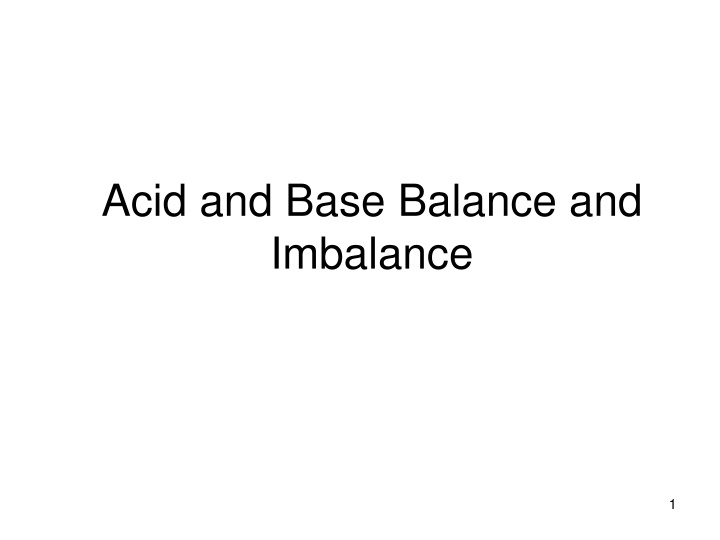
Acid-Base Balance and Imbalance in the Body
Learn about the critical role of pH in the body's balance, the differences between acids and bases, the importance of maintaining pH homeostasis, and how the body controls acids through buffer systems. Discover the impact of small pH changes on enzyme function, electrolytes, and hormones, as well as the reasons why the body produces more acids than bases.
Download Presentation

Please find below an Image/Link to download the presentation.
The content on the website is provided AS IS for your information and personal use only. It may not be sold, licensed, or shared on other websites without obtaining consent from the author. If you encounter any issues during the download, it is possible that the publisher has removed the file from their server.
You are allowed to download the files provided on this website for personal or commercial use, subject to the condition that they are used lawfully. All files are the property of their respective owners.
The content on the website is provided AS IS for your information and personal use only. It may not be sold, licensed, or shared on other websites without obtaining consent from the author.
E N D
Presentation Transcript
Acid and Base Balance and Imbalance 1
pH Review pH = - log [H+] H+ is really a proton Range is from 0 - 14 If [H+] is high, the solution is acidic; pH < 7 If [H+] is low, the solution is basic or alkaline ; pH > 7 2
Acids are H+ donors. Bases are H+ acceptors, or give up OH- in solution. Acids and bases can be: Strong dissociate completely in solution HCl, NaOH Weak dissociate only partially in solution Lactic acid, carbonic acid 5
The Body and pH Homeostasis of pH is tightly controlled Extracellular fluid = 7.4 Blood = 7.35 7.45 < 6.8 or > 8.0 death occurs Acidosis (acidemia) below 7.35 Alkalosis (alkalemia) above 7.45 6
Small changes in pH can produce major disturbances Most enzymes function only with narrow pH ranges Acid-base balance can also affect electrolytes (Na+, K+, Cl-) Can also affect hormones 8
The body produces more acids than bases.WHY?? Acids take in with foods Acids produced by metabolism of lipids and proteins Cellular metabolism produces CO2. CO2 + H20 H2CO3 H+ + HCO3- 9
Control of Acids 1. Buffer systems Take up H+ or release H+ as conditions change Buffer pairs weak acid and a base Exchange a strong acid or base for a weak one Results in a much smaller pH change 10
A-Bicarbonate buffer Sodium Bicarbonate (NaHCO3) and carbonic acid (H2CO3) Maintain a 20:1 ratio : HCO3- : H2CO3 HCl + NaHCO3 H2CO3 + NaCl NaOH + H2CO3 NaHCO3 + H2O 11
B-Phosphate buffer Major intracellular buffer H+ + HPO42- H2PO4- OH- + H2PO4- H2O + H2PO42- 12
C-Protein Buffers Includes hemoglobin, work in blood and ISF Carboxyl group gives up H+ Amino Group accepts H+ Side chains that can buffer H+ are present on 27 amino acids. 13
2. Respiratory mechanisms Exhalation of carbon dioxide Powerful, but only works with volatile acids CO2 + H20 H2CO3 Body pH can be adjusted by changing rate and depth of breathing H+ + HCO3- 14
3. Kidney excretion Can eliminate large amounts of acid Can also excrete base Can conserve and produce bicarb ions Most effective regulator of pH If kidneys fail, pH balance fails 15
Acid-Base Imbalances pH< 7.35 acidosis pH > 7.45 alkalosis The body response to acid-base imbalance is called compensation May be complete if brought back within normal limits Partial compensation if range is still outside normal. 18
Metabolic Acidosis Bicarbonate deficit - blood concentrations of bicarb drop below 22mEq/L Causes: Loss of bicarbonate through diarrhea or renal dysfunction Accumulation of acids (lactic acid or ketones) Failure of kidneys to excrete H+ 22
Metabolic Alkalosis Bicarbonate excess - concentration in blood is greater than 26 mEq/L Causes: Excess vomiting = loss of stomach acid Excessive use of alkaline drugs Certain diuretics Endocrine disorders Heavy ingestion of antacids Severe dehydration 24
Compensation for Metabolic Alkalosis Alkalosis most commonly occurs with renal dysfunction, so can t count on kidneys Respiratory compensation difficult hypoventilation limited by hypoxia 25
Symptoms of Metabolic Alkalosis Respiration slow and shallow Hyperactive reflexes ; tetany Often related to depletion of electrolytes Atrial tachycardia Dysrhythmias 26
Treatment of Metabolic Alkalosis Electrolytes to replace those lost IV chloride containing solution Treat underlying disorder 27
Example A patient is in intensive care because he suffered a severe myocardial infarction 3 days ago. The lab reports the following values from an arterial blood sample: pH 7.3 HCO3- = 20 mEq / L ( 22 - 26) pCO2 = 32 mm Hg (35 - 45) 29
Diagnosis Metabolic acidosis With compensation 30






















